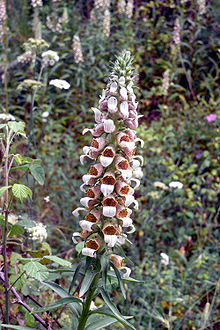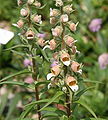- Digitalis lanata
-
Digitalis lanata Digitalis lanata Scientific classification Kingdom: Plantae (unranked): Angiosperms (unranked): Eudicots (unranked): Asterids Order: Lamiales Family: Plantaginaceae Genus: Digitalis Species: D. lanata Binomial name Digitalis lanata Digitalis lanata (often called the Woolly Foxglove or Grecian Foxglove) is a species of foxglove that is part of the Plantaginaceae family. It gets its name due to the texture of the leaves. Digitalis lanata, like some other foxglove species, is highly toxic in all parts of the plant. Even the ingestion of small amounts by humans can be fatal particularly for children. Symptoms of digitalis poisoning include nausea, vomiting, severe headache, dilated pupils, problems with eyesight, and convulsions at the worst level of toxicity. The plant is also harmful to animals as well not just humans. In some cases it is considered invasive or a noxious weed. Minnesota is one of the few places that consider it invasive as noted by the Western Weed Society. It is in leaf all year, in flower in June and July, and the seeds ripen in early-mid September. The flowers are hermaphroditic (having both male and female organs). Bees pollinate the flowers as a result the flowers are quite attractive.
Contents
Description
The plant commonly grows from 0.3 to 0.6 meters in height, or about 13 to 26 inches. The plant prefers part shade and humus rich soil. The plant also prefers sandy, loamy, and clay soils. It can grow under dry or moist conditions. Seeds develop in pods that have small hooks, enabling the pods to be transported by animal fur or clothing. The elongated leaves are mid–green, wooly, veined, and covered with white hairs on the underside. They also have a very bitter taste. There is a tidy rosette before the spike goes up, and it is neatly arranged around the purple-tinged stems. The flowers are tubular and bell shaped with a creamy-white color and purplish-brown netting as well as a long broad lip. The flowers usually bloom in the second year. Both flowers and stems are also woolly or hairy as well as pretty.
Distribution
It is found mostly in Eastern Europe. One of the biggest populations can be found near Bácsalmás in Hungary. Even though it is native to Europe, the plant can now be found throughout the world, growing in woodland areas, on roadsides, and in mountainous regions. In North America, it can be found mostly in the Northeast and Southwest regions. It is cultivated mainly in New York, Washington, Utah, and Colorado.
-
DILA3.png
North American Distribution of Digitalis lanata
Taxonomy
The Plantaginaceae family, also known as the plantain family, is a family of flowering plants included in the order Lamiales. The Plantaginaceae family was not originally placed in the order Lamiales, but in the order Plantaginales. However, in recent years phylogenetic studies conducted by the Angiosperm Phylogeny Group have indicated that it should be included in the order Lamiales. The original family name was Veronicaceae until 1789 when the family name became Plantaginaceae. This is the conserved name under the International Code of Botanical Nomenclature (ICBN). ICBN does not consider family names before 1789 for conservation, as a result Veronicaceae is not eligible for conservation. Digitalis lanata has several other common names such as Grecian Foxglove and Woolly Foxglove. The name Digitalis comes from the Latin word digitus, which means finger. Digitalis was first recorded in the English language in 1664 in a published work. This genus name was chosen because the German name for foxglove is Fingerhut, which means finger hat (thimble). The glove portion of the name originates from the similarity of the foxglove blossoms to the fingers of a glove.
Medical uses
Digitalis lanata contains a powerful cardiac glycoside that may be used by patients with heart conditions. Digoxin (Digitalin) is a drug that is extracted from Digitalis lanata. It is used to treat some heart conditions such as atrial fibrillation. It slows atrioventricular conduction so that the heartbeat slows down and very slightly increases contraction power (positive inotropic effect). Because of the improved circulation in congestive heart failure caused by fast atrial fibrillation, the kidneys can function better, which stimulates the flow of urine, which lowers the volume of the blood and lessens the load on the heart. This is the effect that was first described when the plant was discovered as a medicine (Withering 1785). Digitalin was not discovered until the mid-19th century by two French scientists Homolle Ouevenne and Theodore Ouevenne. It wasn’t until 1875 that Oscar Schmiedberg identified digoxin in the plant.[1] It was first isolated in the 1930s in Britain by Dr. Sydney Smith.[2][3] Back then it was used to treat ulcers in the lower abdomen, boils, headaches, abscesses, and paralysis, and externally healing wounds. Today it is still extracted from the plant because synthetis is quite expensive and difficult. However, it is becoming less frequently used due to the narrow therapeutic margin and high potential for severe side effects. Digoxin is being replaced by newer drugs including beta blockers, angiotensin-converting enzyme inhibitors, and the calcium channel blocking agents. As new pharmacotherapeutic agents arise, the use of digitalis preparations will continue to decline. There are also other commercial uses for Digitalis lanata other than heart conditions. For example, in South America the powdered leaves are used to relieve asthma, as sedatives, and as diuretics. In India it is used as an ointment that contains digitalis glycosides used to treat wounds and burns.
Pictures
References
[4] [5] [6] [7] [8] [9] [10] [11] [12] [13] [14] [15] [16] [17] [18] [19]
- ^ G. Dragendorff (1884). Plant Analysis Qualitative & Quantitative. London: Bailliere, Tindall and Cox. p. 142.
- ^ George Edward Trease (1961). A text book of Pharmacognosy. London: Bailliere, Tindall and Cox. p. 513.
- ^ Sydney Smith III (1931). "Digitalis glucosides". Journal of the Chemical Society 23 (3).
- ^ Niazi, Sarfaraz. Handbook of Pharmaceutical Manufacturing Formulations: Compressed Solid Products. Boca Raton: CRC, 2004.
- ^ http://www.robsplants.com/plants/DigitLanat.phpl
- ^ http://davesgarden.com/guides/pf/go/749/
- ^ http://onlinedictionary.datasegment.com/word/digitalis+lanata
- ^ http://www.bmj.com/cgi/content/full/312/7035/912
- ^ http://plants.usda.gov/java/profile?symbol=DILA3
- ^ http://www.drugs.com/npp/digitalis.html
- ^ http://www.pfaf.org/database/plants.php?Digitalis+lanata
- ^ http://www.piam.com/mms_garden/plants.html
- ^ http://www.ksda.gov/plant_protection/content/355/cid/679
- ^ http://www.ksda.gov/includes/document_center/plant_protection/Miscellaneous_Plans_Reports_and_Guidelines/gfox.pdf
- ^ http://www.innvista.com/health/herbs/foxglove.htm
- ^ http://www.discoveriesinmedicine.com/Com-En/Digitalis.html
- ^ http://en.wikipedia.org/wiki/Plantaginaceae
- ^ http://data.gbif.org/datasets/resource/1905
- ^ http://www.thefreedictionary.com/digitalis
External links
Categories:
Wikimedia Foundation. 2010.










